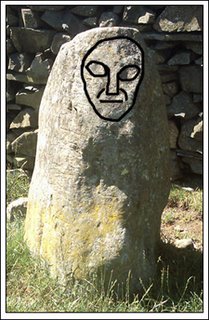
You might be wondering at this point: “Where’s the simulacra?” Well, apparently, it was an awful lot clearer from a distance and the photograph doesn't exactly do it justice. However, with the aid of a little computer technology, (all right...I used the paintbrush in Adobe Photoshop) we can give you some impression of what it looked like in reality.

Von Danikon (or however his name was spelt) would be having a fit by now. But let’s not move too far into the realms of flying saucers and greys and such. This style of carving (if, course, it is a carving and not just some coincidental weather erosion) can be found elsewhere in the historic world, such as on the Iron Age ‘Gundestrup Cauldron’ discovered in a bog in Denmark. Long pointed faces and almond shaped eyes are common in Iron Age decorations.
The Castlerigg stone certainly shows signs of having been worked by hand, as the following photograph taken from the side demonstrates.

So, was the face deliberately carved or not? Again, it’s impossible to say but, like John's discovery at Stone Henge, it’s not an idea that should be instantly dismissed.



















2 comments:
By any chance, do you recall if this stone face was facing east? If this photo was taken around noon, then the sun could be striking it from the south, after having moed from the east, which is where the face appears to be facing.
AS I mentioned earlier, I am not entirely convinced that these faces are deliberate carvings. I would need to see one face to , er... face, and perhaps feel the stone to see if there are indications of being worked.
Any chance of you being able to visit this site again?
My guess is, if this is real, that these faces came later. Perhaps the original builders of these stone monuments underestimated their ease of use and the clarity of understanding for those who came later? Perhaps the faces make these celestial calendars easier to understand... a kind of 'solstices for dummies'?
I'm being funny, but the idea is valid, and again, worth further study.
Cheers, JOHN :0)
I'm not sure which way the stone was facing because I wasn't actually there when Michelle took the photograph. And, because the circle is in Cumbria, we won't be visiting it again any time soon. (It's not exactly a massive distance to travel, I know, but it might be a bit too much on the old arthritic knee joints if we attempted the journey on bicycles.)
I do know, however, that some years ago, using pioneering photographic techniques, archaeologists apparently discovered carvings of axes on some of the monoliths at Stone Henge. If they were carving axes into them, why not faces? It's certainly intriguing and worth keeping an open mind about I reckon.
Post a Comment